How Does Repair Shop Flowchart Looks Like
Car Repair Process
This example simulates the procedure menses of a Car Repair store. The BPSim configuration:
- Uses a property parameter initialized by distribution to generate a random number of issues for each customer
- Applies probability to simulate:
- Acceptance of the initial guess or not
- Whether new issues volition be constitute during repair
- Increments or decrements the property parameter's value in each chore
- Uses the holding parameter's value on conditions of Sequences outgoing from Gateways
- Simulates the client arrivals for a given start and duration
Create BPMN Model
Create the main process
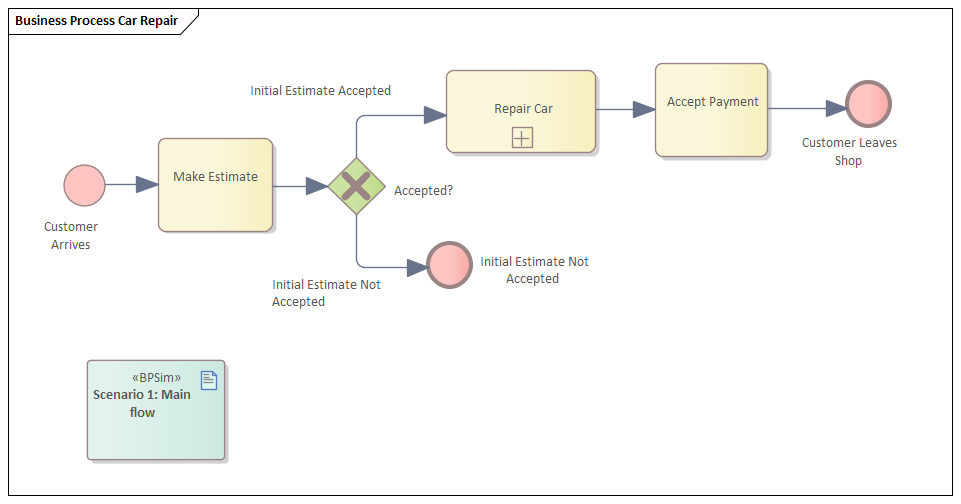
- Create a Start Event Customer Arrives.
- Add a Sequence Menses to a target abstract task Activity Make Approximate.
- Add together a Sequence Menses to a target Exclusive Gateway Accepted?.
- Add Sequence Flows to:
- A target End Outcome Initial Estimate Not Accepted
- A target subProcess Repair Car - From Repair Car, add a Sequence Flow to a target abstract task Activity Accept Payment.
- Add a Sequence Catamenia to a target End Event Customer Leaves Shop.
Create the sub process Repair Motorcar
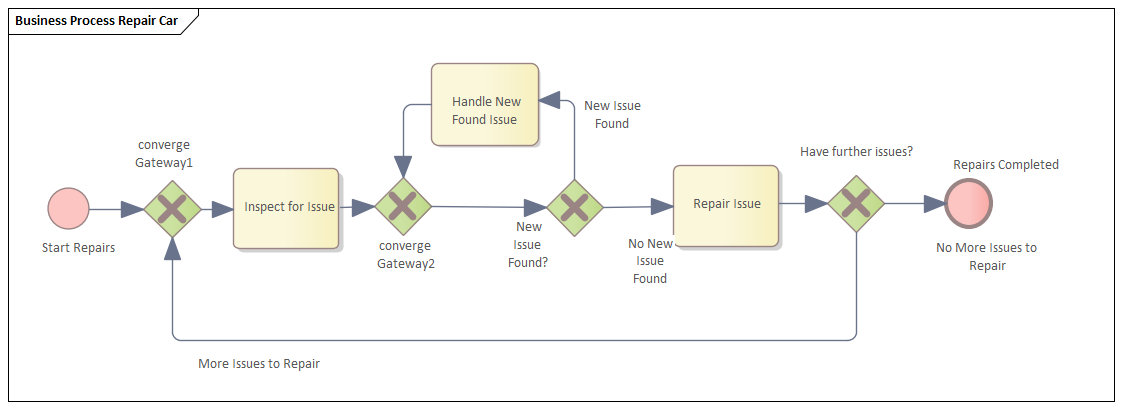
- Create a Commencement Effect Start Repairs.
- Add a Sequence Flow to a target Exclusive Gateway converge Gateway1.
- Add together a Sequence Flow to an abstract task Activity Inspect for Issue.
- Add a Sequence Flow to an Exclusive Gateway converge Gateway2.
- Add a Sequence Flow to an Exclusive Gateway New Issue Establish?.
- Add Sequence Flows to:
- A target abstruse job Activity Handle New Constitute Issue, and then add a
Sequence Flow back to converge Gateway2
- A target abstract task Repair Issue, and so add a Sequence Flow to a
target Exclusive Gateway Take further issues? - From the Gateway Have further problems? add together Sequence Flows to:
- The target Terminate Issue Repairs Completed
- converge Gateway1
Configure BPSim
| Artifact and Package |
|
| Kickoff and Duration | We will simulate the processes in a car repair shop whose opening hours are from nine:00 am to 5:00 pm, which is a period of 8 hours. We also suppose that a customer walking in after 4:fifty pm will not exist served on that twenty-four hours. Therefore the simulation Start time is nine:00 am and the duration is 7 hours and 50 minutes. On the 'Car Repair' diagram, click on the Business Process Simulation Artifact named Scenario 1: Main Flow and, on the Configure BPSim window, update these ScenarioParameters:
|
| Customer Arrives | We will simulate a customer arriving every 24 minutes. The outset customer arrives at nine:00 AM and the last arrives at iv:36 PM (the customer arriving at v:00 PM will not be served today because that is constrained past the 'Duration' setting). With a pen and newspaper, we tin summate that there are 20 customers served (9:00 AM to 4:36 PM = 456 minutes; number of customers is 456/24 + ane = 19 + 1 = 20). Nosotros volition verify this with the simulation result later. On the 'Car Repair' diagram, click on the Starting time Event element Client Arrives, and in the Configure BPSim window:
|
| Property Parameters | We suppose each customer's auto might initially have a different number of problems. This could be reflected using a random number generator. BPSim provides a number of distributions to suit your needs. In this case, we employ a Truncated Normal distribution to initialize the property noOfIssues. Tasks Repair Issue and Handle New Found Issue volition decrement and increment the value of noOfIssues respectively.
Important Annotation: Distributions such every bit 'TruncatedNormal', return a floating point value, but the property is used equally an integer. Setting the property's type is of import, peculiarly in condition expressions when testing with equality. For case, the condition expression getProperty('noOfIssues') = 0 will most never be satisfied considering noOfIssues was initialized past a floating point distribution. Tip: How to customize the type for a property Later on you create the property and set a value, click on the
|
| Probability on Sequence Flows | We estimate that ane in three of the customers will non accept the initial judge for repairs and the remaining two volition accept it. We besides approximate that for one in four of the repairs new issues will exist found, and for the remaining three repairs no new issues will be found. On the 'Auto Repair' diagram, refer to the Gateway element Accustomed?. Click on the:
On the 'Car Repair' diagram, refer to the Gateway element New Issue Found?. Click on the:
|
| Condition on Sequence flows | Nosotros employ an expression to render a Boolean value as a Sequence Flow'south status, which plays a key role in the period's logic. On the 'Repair Car' diagram, refer to the Have Farther Bug? Gateway element. Click on the:
Notation: All the outgoing transitions from a Gateway should include 100% of the logic; for example, you would non enter {noOfIssues} > ten and {noOfIssues} < five every bit condition expressions, because values in the range [5, 10] volition not be handled by any approachable Sequence Flows. |
Run Simulation
- On the Configure BPSim window click on the 'Execute' tab and on the
 icon in the toolbar.
icon in the toolbar. - When the simulation is consummate, the Execute tab provides results similar to these:
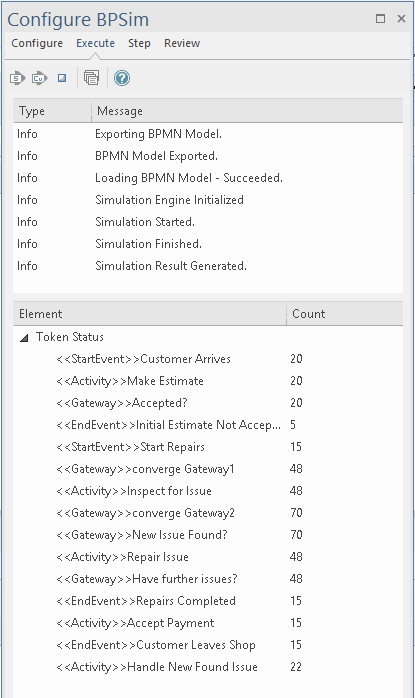
Token Analysis
- 20 customers arrived, matching the number we calculated manually (run across Customer Arrives in the Configure BPSim tabular array)
- viii customers out of the twenty did not accept the initial estimate, whilst 12 of the twenty accepted and had their car repaired; these figures roughly match the 1/3 and 2/3 probabilities
- 64 tokens passed the Gateway New Event Plant?, of which 19 had new problems and 45 did non; these figures roughly match the 1/4 and 3/iv probabilities
Analysis on individual customers
Click on the ![]() button on the toolbar to open up the 'BPSim PropertyParameter Values' dialog. As there are 20 customers (tokens), y'all can input a value between 0 and 19 in the 'Token Number' field and click on the to practice some analysis:
button on the toolbar to open up the 'BPSim PropertyParameter Values' dialog. As there are 20 customers (tokens), y'all can input a value between 0 and 19 in the 'Token Number' field and click on the to practice some analysis:
- This customer did not have the initial estimate, as shown on the 'Group by Property' tab:

- This customer'south auto had but 1 issue, which was fixed:
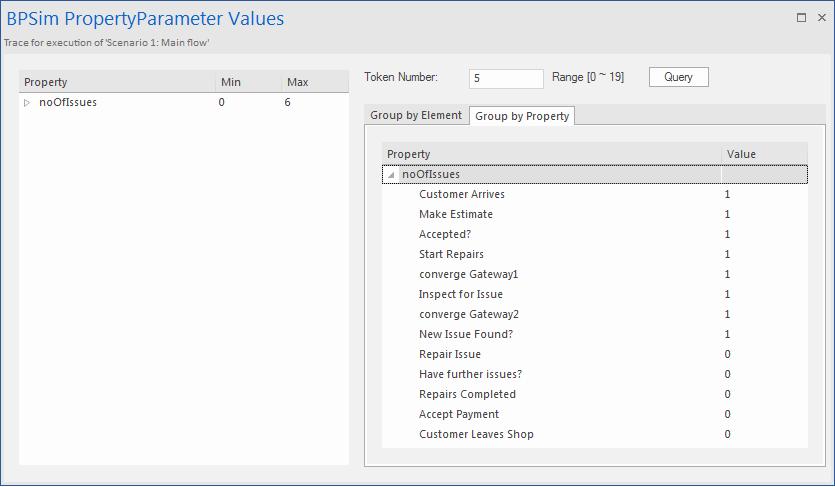
- This client'south machine had 3 known issues and three other issues were found during repair, then in full vi issues got fixed (perhaps this is a actually old car); switching to the 'Grouping past Element' tab:
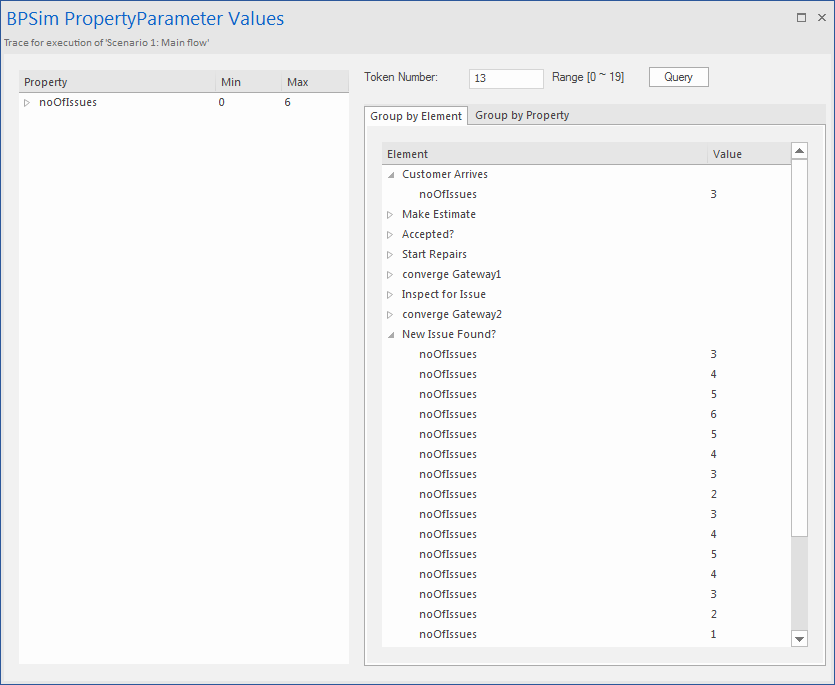
How Does Repair Shop Flowchart Looks Like,
Source: https://sparxsystems.com/enterprise_architect_user_guide/15.2/model_simulation/car_repair_process.html
Posted by: tollivermiltary.blogspot.com

 button in the 'Values' field and set information technology to a Constant Duration of '0 07:50:00'
button in the 'Values' field and set information technology to a Constant Duration of '0 07:50:00' icon on the toolbar, so click on the
icon on the toolbar, so click on the  icon to display the 'Edit Property Parameters' dialog. In the 'Type' field for the property, click on the drop-downward arrow and select the value 'int' instead of the default 'double'.
icon to display the 'Edit Property Parameters' dialog. In the 'Type' field for the property, click on the drop-downward arrow and select the value 'int' instead of the default 'double'.
0 Response to "How Does Repair Shop Flowchart Looks Like"
Post a Comment